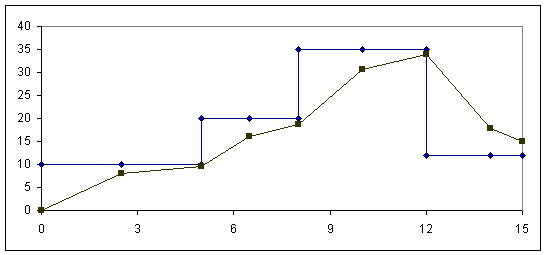Dynamic Performance
This is a measure of how well a system
responds to a changing input. The
dynamic specification can be defined by applying one or all of three different
inputs and examining the resultant output.

The Step or Transient Response comes from the
Step Input. The Ramp Response is given
by the Ramp input and the Frequency Response is produced by the Sine Wave
Input.
Zero
Order Systems are defined as follows. The
output of a zero order system is proportional to the input. At all times, the output is equal to the
input multiplied by some constant of proportionality.
Output qo = k x Input qi
qo = kqi
Where k is a proportionality constant.
Example – rheostat, potentiometer. The voltage/resistance (output) instantly
changes when the wiper is moved (input).

![]()
First
Order Systems ultimately reach the same result as zero order systems except that
they take some time to get there when a step input is applied.
The relationship between the output and the
input is given by the following equation:
![]()
where a, b and c are constants.
This equation is normally written as follows:
![]()
where t=a/b and is the time
constant in seconds
K=c/b
and is the static sensitivity (units depending on application)
The form of the step response is shown as
follows:

The above curve is an exponential rise to a
final value. The equation that relates
the output to time is as follows:
![]()
where qinitial is the steady
state value before the step input is applied and qfinal is the steady
state value after the step input is applied, i.e. after the exponential rise.
The time constant, t, is the length of time for the output to reach 63.2% of its final value. It takes almost five time constants for the output to reach its final value.
Thermometer
example
Example. A thermocouple housed in a protective sheath has an output voltage of qout Volts and an input temperature of qin°C. Determine the time constant and the static sensitivity for this system if its dynamic performance is given by the following equation:
![]()
Solution. This equation is of the form given above. Rearranging slightly to give a unity coefficient for the qout term gives the following equation:
![]()
This is of the form:
![]()
Therefore, the time constant t=10 and the static
sensitivity k=0.5x10-5.
Example. A pressure transducer which has a first
order characteristic has pressures applied at the times shown in the following
table:
|
Pressure (psi) |
Time (sec) |
|
10 |
0 |
|
20 |
5 |
|
35 |
8 |
|
12 |
12 |
If the time constant of the device is 6
seconds, what is the pressure recorded at the end of each time interval and
sketch the approximate relationship between pressure and time over 15
seconds. The initial pressure is 0 psi.
Solution:
The equation to use is, from above:
![]()
This is easily calculated and plotted using
excel. Construct a spreadsheet as
follows:
|
Time, t (sec) |
Dt |
Applied Pressure |
Calculation |
Output Pressure |
|
0 |
- |
10 |
- |
0 |
|
5 |
5 |
20 |
0+(10-0)(1-exp(-5/6)) |
5.65 |
|
8 |
3 |
35 |
5.65+(20-5.65)(1-exp(-3/6)) |
11.30 |
|
12 |
4 |
12 |
11.3+(35-11.3)(1-exp(-4/6)) |
22.83 |
|
15 |
3 |
12 |
22.83+(12-22.83)(1-exp(-3/6)) |
18.57 |

Add in some
extra rows with extra times and calculations to improve the chart.
Note that for this example the output
pressure never has enough time to reach the applied pressure because of the
value of the time constant. Try
changing the time constant to 1.5seconds and see what happens to the chart
(easily done in excel).

The output pressure almost reaches the
applied pressure before it is changed.
Remember, five time constants are needed to reach the applied pressure.
The frequency response of a first order
system is obtained by applying sine waves of known amplitude at the input and
examining the output response.

Bandwidth
Second
order systems are defined by a second order differential equation. They can be underdamped leading to
overshoot; they can be critically damped in which case the transient response
looks like that of a first order system; or they can be overdamped resulting in
sluggish behaviour without overshoot.